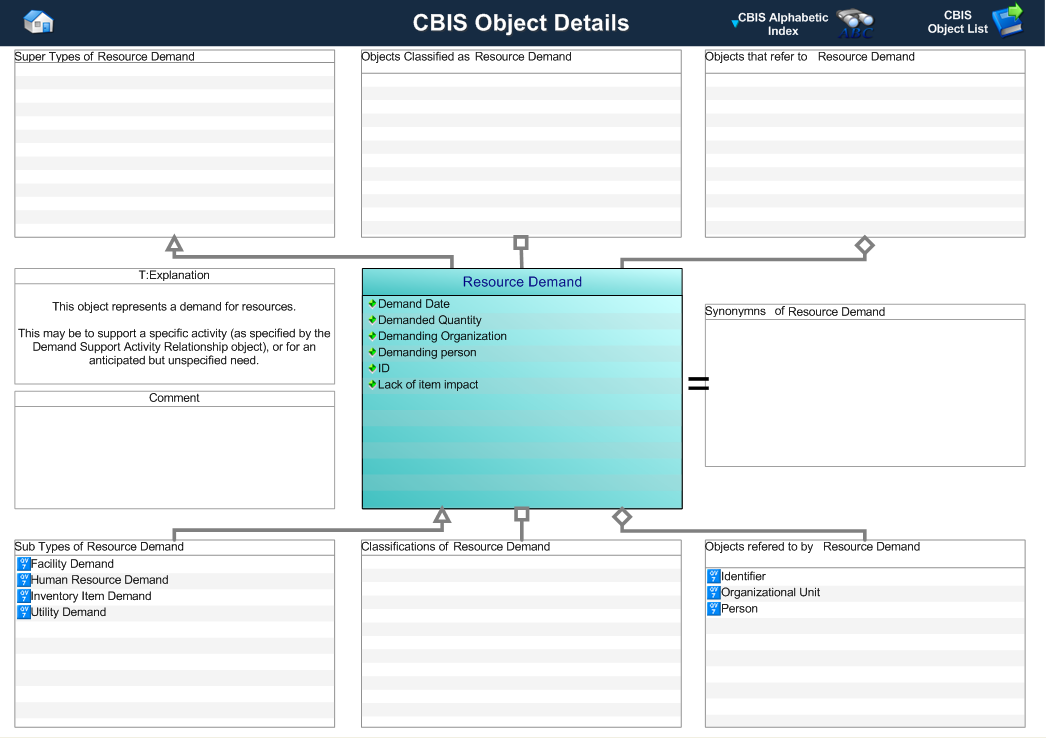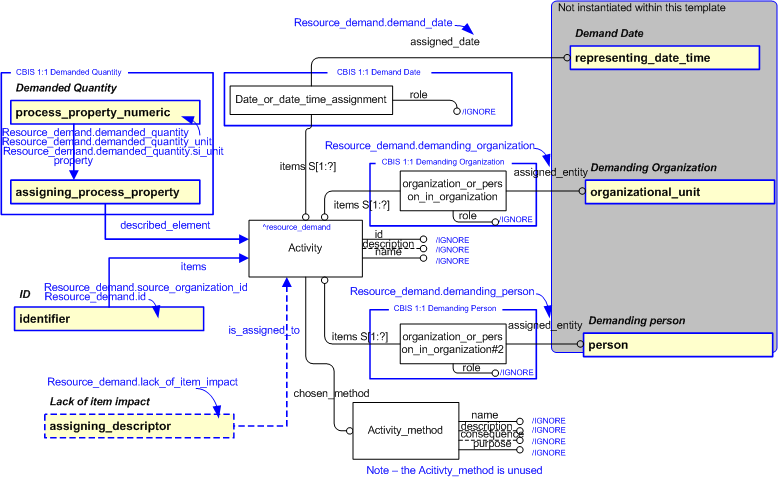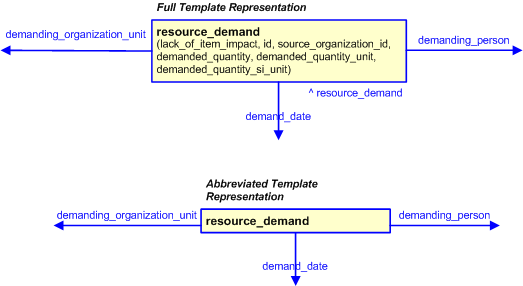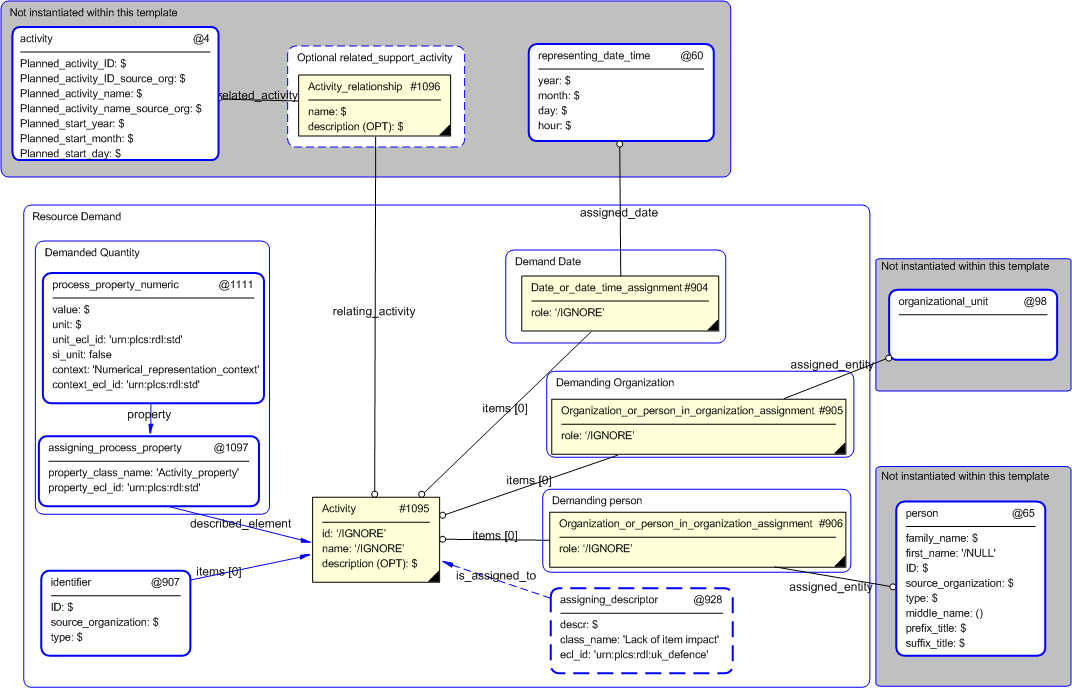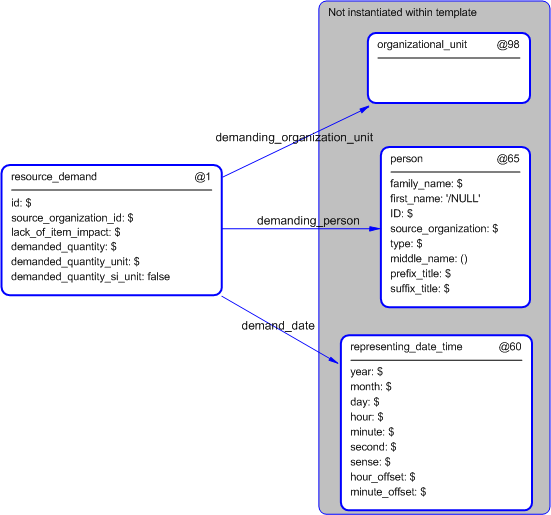Template:— resource_demand (res_dmnd)
Context:— UK_Defence |
Date: 2009/04/17 11:42:30
Revision: 1.7
|
This section specifies the template resource_demand.
NOTE
The template has been defined in the context of
UK_Defence.
Refer to the business context for details of related templates.
NOTE
An explanation of a template and the associated instantiation path is
provided in the
Template overview
section.
This template describes how to represent a demand for resources.
Resource Demand is the means of demanding resources to support a specific activity, or for an anticipated but unspecified
need.
This information object represents the information about a Resource Demand.
Figure 1 — A MOOD Business Architect representation of the Business Object: Resource Demand
The attributes of the Resource Demand object are tabled below.
|
Attribute name
|
Attribute description
|
Attribute type
|
Optionality
|
| Demand Date |
This is the date the resource demand is made. |
Relationship to Date_time |
Mandatory |
| Demanded Quantity |
This is the quantity of the demanded. |
Intrinsic |
Mandatory |
| Demanding Organization |
This is a reference to the organization or unit demanding the resource. |
Relationship to Organizational Unit |
Mandatory |
| Demanding person |
This is a reference to the person making the resource demand. |
Relationship to Person |
Mandatory |
| Identifier.id |
This is the identifier of the the resource demand. |
Identifier |
Mandatory |
| Identifier.type |
This attribute is the type associated with the id of the Identifier given to the resource demand. This must be one of the
classes provided.
|
Resource_demand_identification_code |
Mandatory |
| Identifier.source_organization |
This attribute is the value representing the source organization that provides the id of the Identifier given to the resource
demand. This value is assumed to be a type of Organization_identification_code.
|
Organization_identification_code |
Mandatory |
| Lack of item impact |
This is the description of the impact of the resource demand not being met. |
intrinsic |
Optional |
Table 1 — Resource Demand attribute details
The EXPRESS-G diagram in
Figure
2
shows the templates and EXPRESS entities that are required
to represent the template
"resource_demand".
The text highlighted in blue shows the template parameters.
Figure 2 — An EXPRESS-G representation of the Information model for resource_demand
The graphic for the template to be used in other EXPRESS-G diagrams
is shown in Figure
3
below.
Figure 3 — The graphical representation of the resource_demand template
The following input parameters are defined for this template:
The identifier assigned to a requirement.
This is the description of the impact of the resource demand not being met.
The organization or unit demanding the resource.
The person making the resource demand.
This is the date the resource demand is made.
The quantity of the demanded resource.
The units of measure for the quantity of the demanded resource.
The following classes and their sub-classes can be used:
Value should be set to true if the unit is a SI base unit defined by ISO, i.e.
kilogram (kg) for Mass,
second (s) for Time,
metre (m) for Displacement,
ampere (A) for Electrical current,
kelvin (K) for Temperature,
mole (mol) for Amount of substance, and
candela (cd) for Luminous intensity. If this is not the case it should be set to false.
Note that the representation of true and false depends on exchange format. In Part 11 (a STEP file) true is
represented by the string ".T.", and false by ".F.", while in Part 28 (XML) they are represented by text strings
"true"
and "false".
The following reference parameters are defined for this template:
Allow the
Activity
entity instantiated in this path to be referenced when this template is used.
Note: The
Activity
entity can be referenced in a template path by:
%^target = $resource_demand.resource_demand%
where
target
is the parameter to which the
Activity
is bound.
The instantiation path shown below specifies the entities that are to be
instantiated by the template.
A description of templates and the syntax for the instantiation path is
provided in the
Templates Help/Information section.
-- Create the Activity to represent the resource_demand concept ActivityActivity.id = '/IGNORE'
Activity.name = '/IGNORE'
-- Note the Activity_method is UNUSED Activity_methodActivity_method.name = '/IGNORE'
Activity_method.purpose = '/IGNORE'
Activity.chosen_method ->
Activity_method%^resource_demand =
Activity%
-- Demand_date Date_or_date_time_assignmentDate_or_date_time_assignment.role = '/IGNORE'
Date_or_date_time_assignment.items ->
^resource_demand
Date_or_date_time_assignment.assigned_date ->
@demand_date-- [Optional 0:1 Lack of item impact] /
assigning_descriptor(
descr=@lack_of_item_impact,
class_name='Lack_of_item_impact',
ecl_id='urn:plcs:rdl:uk_defence',
is_assigned_to=^resource_demand)/
-- id /
identifier(
items=^resource_demand,
ID=@id,
type='Resource_demand_identification_code',
source_organization=@source_organization_id)/
-- Demanding Organization Organization_or_person_in_organization_assignmentOrganization_or_person_in_organization_assignment.role = '/IGNORE'
Organization_or_person_in_organization_assignment.items ->
^resource_demand
Organization_or_person_in_organization_assignment.assigned_entity ->
@demanding_organization_unit-- Demanding Person -- Note this is a second instance or usage of Organization_or_person_in_organization_assignment - Graphical Instance cannot
handle this -- G.I. needs to know this is a new instance and not a reuse of the previous one Organization_or_person_in_organization_assignmentOrganization_or_person_in_organization_assignment.role = '/IGNORE'
Organization_or_person_in_organization_assignment.items ->
^resource_demand
Organization_or_person_in_organization_assignment.assigned_entity ->
@demanding_person-- Demanded_quantity /
assigning_resource_property(
property_class_name='Activity_property',
property_ecl_id='urn:plcs:rdl:uk_defence',
described_element=^resource_demand)/
%^property_qty = $assigning_resource_property.property%
/
resource_property_numeric(
value=@demanded_quantity,
unit=@demanded_quantity_unit,
unit_ecl_id='urn:plcs:rdl:uk_defence',
si_unit=@demanded_quantity_si_unit,
context='Numerical_representation_context',
context_ecl_id='urn:plcs:rdl:uk_defence',
property=^property_qty)/
The following entities are instantiated with attributes as specified:
The instance diagram in Figure
4
shows an example of the EXPRESS entities and templates that are instantiated by the template:
/resource_demand(id='', source_organization_id='', lack_of_item_impact='', demanding_organization_unit='@98', demanding_person='@65', demand_date='@60', demanded_quantity='', demanded_quantity_unit='', demanded_quantity_si_unit='.F.')/
(an illustration of the consolidated resource_demand template is shown in
Figure
5 below.)
Figure 4 — Entities instantiated by resource_demand template
The instance diagram in
Figure
5
shows the graphic symbol for the template that is to be
used in other instance diagrams. The example template is:
/resource_demand(id='', source_organization_id='', lack_of_item_impact='', demanding_organization_unit='@98', demanding_person='@65', demand_date='@60', demanded_quantity='', demanded_quantity_unit='', demanded_quantity_si_unit='.F.')/
Figure 5 — Instantiation of resource_demand template
Characterizations
No common characterizations of the template
resource_demand
have been identified. However, the ISO 10303-239 EXPRESS model
may enable other assignments to the entities instantiated by the template.
